Types of nasturtium used to decorate home gardens
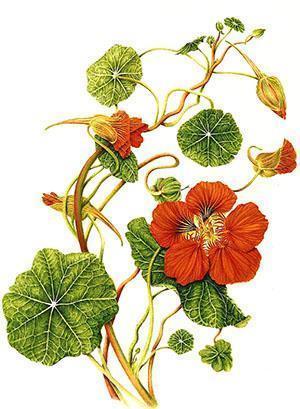 Nasturtium appeared in orchards and vegetable gardens almost simultaneously with potatoes, sunflowers and corn. Like these cultures, it comes from the South American jungle.
Nasturtium appeared in orchards and vegetable gardens almost simultaneously with potatoes, sunflowers and corn. Like these cultures, it comes from the South American jungle.
Features of the numerous genus Tropaeolum
In nature, there are about nine dozen types of nasturtium. And with all the variety, be it multi-meter creeping or climbing vines, half-shrubs or modest plants no more than 30 cm high, all nasturtiums have common features, thanks to which they got their generic name Tropaeolum.
When describing plants, it was noticed that dense leaves on long stalks are very similar to shields, and the shape of the corollas resembles fancy helmets. Since the flowers were foreign, they were compared to the "trophae", a small trophy. You can hear that nasturtium called a capuchin, the painfully bright cups of flowers decorated with spurs look like deep monastic hoods.
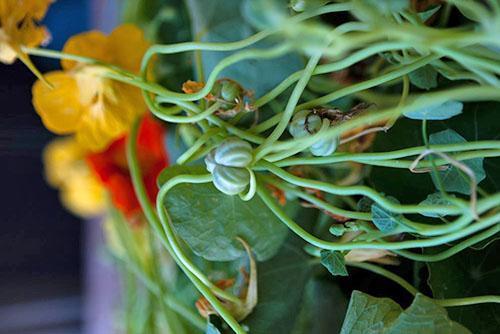 In all species, whether curly or erect nasturtium:
In all species, whether curly or erect nasturtium:
- very juicy, fleshy stems;
- single flowers on long peduncles emanating from the leaf axils;
- alternately arranged thyroid or round fleshy leaves;
- long elastic petioles, like leaves, often covered with a waxy coating;
- prefabricated fruits, after ripening, dividing into three round, wrinkled seeds.
In the countries of South and Central America, where the climate permits, nasturtium is a perennial plant. It is impossible to achieve this in the middle lane, but it is not difficult to get a plant that effectively blooms throughout the summer on the site with the help of seeds. Ripening in a season and retaining germination for up to five years, the fruits of nasturtium give powerful shoots in two weeks, from which not only decorative species of nasturtium are obtained, but also nasturtiums, which give edible leaves, fruits, flowers and even tubers.
Therefore, when planting and caring for nasturtium, it is important to take into account the purpose and characteristics of the cultivated species and variety.
Curly foreign nasturtium (T. peregrinum)
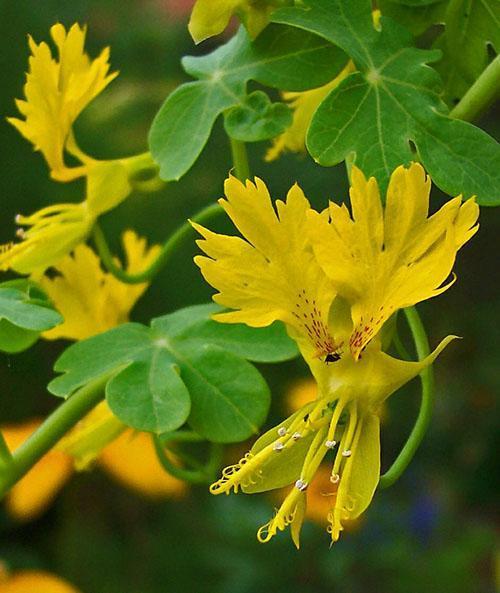 Foreign nasturtium, in comparison with other varieties, has probably the most original and memorable appearance.
Foreign nasturtium, in comparison with other varieties, has probably the most original and memorable appearance.
Foreign nasturtium has medium-sized, seven-part leaves of a light green hue and yellow, with flowers excised along the edge of the petals. Blooming of climbing nasturtium in the open field begins in the middle of summer and ends only with the arrival of frost. Under favorable conditions, over the summer, the liana manages to give curly stems up to 3.5 meters high.
Such a volume of green mass cannot do without reliable support, a sufficient amount of sun and abundant glaze... The best place to plant is a wall, terrace, garden fence, or sturdy trellis to protect the nasturtium from the wind. To bring flowering closer and improve the quality of seeds, it is better to plant foreign nasturtium in the ground with seedlings.
Small nasturtium (T. minus)
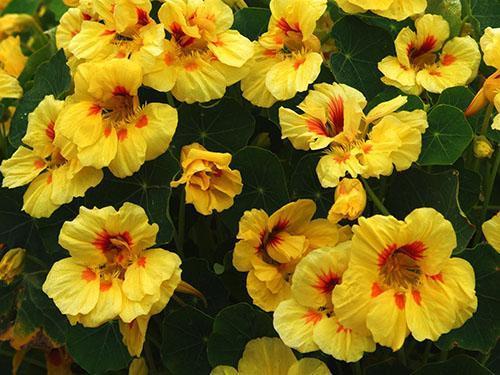 The stalks of the smallest species of nasturtium are thin, highly branching and reaching a length of 25–35 cm. On the lashes there are many small rounded leaves on graceful long petioles. The flowers of small nasturtium, with a diameter of only 3 cm, are yellow with spots on the petals. The spurs of this species are short and slightly curved.
The stalks of the smallest species of nasturtium are thin, highly branching and reaching a length of 25–35 cm. On the lashes there are many small rounded leaves on graceful long petioles. The flowers of small nasturtium, with a diameter of only 3 cm, are yellow with spots on the petals. The spurs of this species are short and slightly curved.
This is one of the most unpretentious nasturtiums, planting and caring for which will not be difficult even for a gardener with little experience.The plant is successfully grown both in containers and in the open field. Flowering begins in June, and the seeds ripen well in the middle lane.
Perennial nasturtium (T. peltophorum)
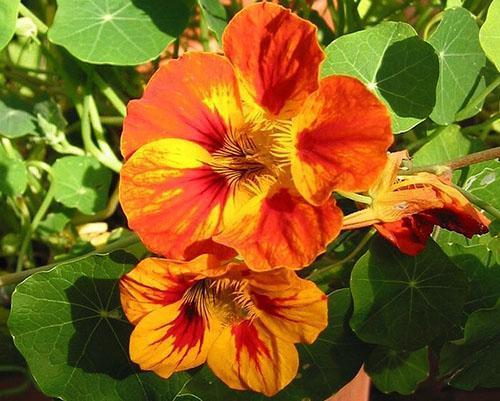 In Ecuador and Colombia, where the plant was originally discovered, this type of nasturtium is known as an unpretentious perennial. Even in a European mild winter, for example, in Great Britain, the four-meter thickets of shield-bearing nasturtium do not freeze, but only stops flowering.
In Ecuador and Colombia, where the plant was originally discovered, this type of nasturtium is known as an unpretentious perennial. Even in a European mild winter, for example, in Great Britain, the four-meter thickets of shield-bearing nasturtium do not freeze, but only stops flowering.
In Russia, the fleshy rhizome of this light-loving culture does not withstand freezing of the soil, therefore, like other nasturtiums, it is planted in the spring with seeds or seedlings. For planting shield-bearing nasturtium, areas protected from drafts are chosen:
- with loose fertile soil with a weak alkaline reaction;
- lit in the upper tier and shaded at root level.
The plant with creeping four-meter stems can be used as a groundcover or grown on supports, making beautiful living garden decorations with its dark green leaves and large, 6-centimeter flowers.
Large nasturtium (T. majus)
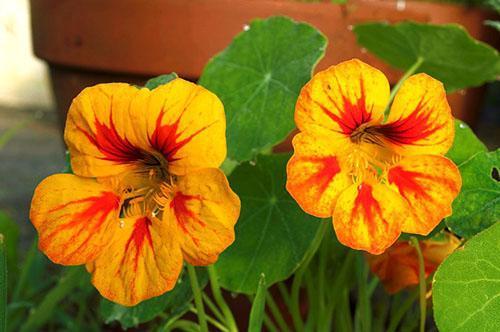 Large nasturtium exists in bush form up to 60 cm in height, as well as in the form of an ampelous plant with stems up to 2.5 meters long. The succulent stems are highly branched and fragile enough. Rounded, thyroid, leaves reach 8 cm in diameter and are covered with a noticeable bluish bloom on the underside.
Large nasturtium exists in bush form up to 60 cm in height, as well as in the form of an ampelous plant with stems up to 2.5 meters long. The succulent stems are highly branched and fragile enough. Rounded, thyroid, leaves reach 8 cm in diameter and are covered with a noticeable bluish bloom on the underside.
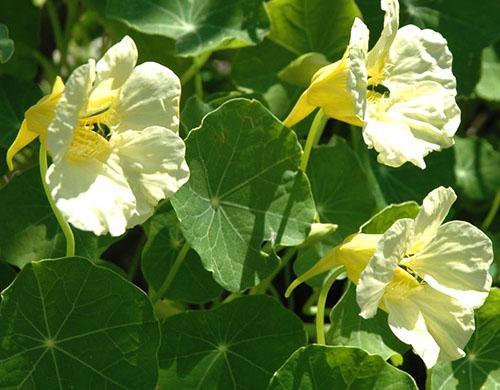 Today gardeners are well aware of both simple and terry nasturtiums of this species with spectacular fragrant flowers of yellow, cream, orange and red colors. There are varieties with variegated flowers in red-orange or yellow colors. A characteristic feature of the species is early and long flowering, as well as abundant self-seeding at the end of the season. In this case, the plant is harmed by abundant nutrition. Nasturtium fattens, creating dense greens, but reducing flowering.
Today gardeners are well aware of both simple and terry nasturtiums of this species with spectacular fragrant flowers of yellow, cream, orange and red colors. There are varieties with variegated flowers in red-orange or yellow colors. A characteristic feature of the species is early and long flowering, as well as abundant self-seeding at the end of the season. In this case, the plant is harmed by abundant nutrition. Nasturtium fattens, creating dense greens, but reducing flowering.
Plain and terry nasturtium cultivated (T. cultorum)
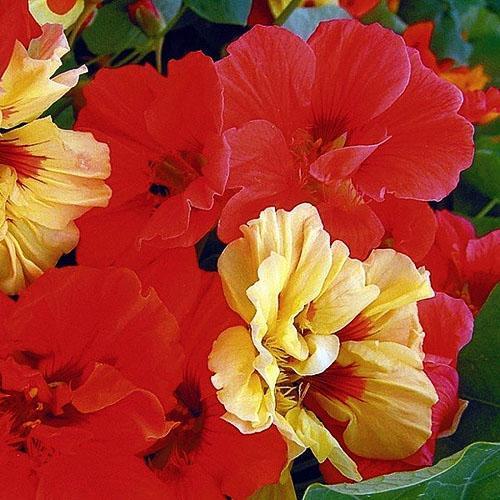 On the basis of nasturtium large and thyroid, today many original hybrids have been bred, united under the common name Tropaeolum cultorum. Plants with a height of 40 cm to 3 m in Russia are grown as annuals. The thyroid leaves of this species can have not only the usual green color, but also have a thick purple hue. Flowers in the characteristic gamut of nasturtiums emanate from the axils of the leaves, have a diameter of up to 5 cm, and are both simple and double.
On the basis of nasturtium large and thyroid, today many original hybrids have been bred, united under the common name Tropaeolum cultorum. Plants with a height of 40 cm to 3 m in Russia are grown as annuals. The thyroid leaves of this species can have not only the usual green color, but also have a thick purple hue. Flowers in the characteristic gamut of nasturtiums emanate from the axils of the leaves, have a diameter of up to 5 cm, and are both simple and double.
Mass flowering and tiny forms no higher than 30 cm, and huge climbing nasturtiums takes place from June to late autumn. During this time, the seeds ripen well and can be used for sowing next spring.
Planting and caring for tuberous nasturtium (T. tuberosum)
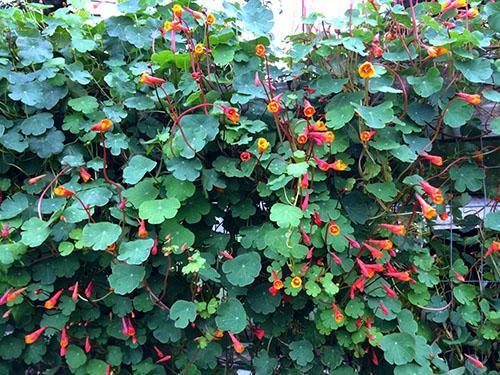 A herbaceous, climbing plant with shoots of three or four meters in length, covered with five-toed small leaves. Funnel-shaped flowers with orange-red or pink sepals open in July, and their number does not decrease until October.
A herbaceous, climbing plant with shoots of three or four meters in length, covered with five-toed small leaves. Funnel-shaped flowers with orange-red or pink sepals open in July, and their number does not decrease until October.
Tuberous nasturtium or Mashua has been included in the diet of the local population in Colombia, Ecuador and Peru for thousands of years. However, in Europe for a long time it was known only as an ornamental plant with powerful stems, capable of climbing to great heights, fixing on the walls with leaf petioles and lateral shoots.
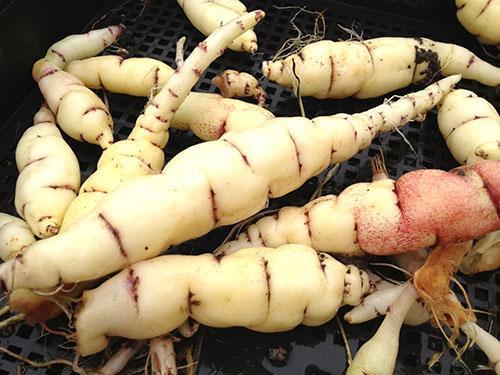 This type of nasturtium, as in its homeland, in the mountainous regions of the Andes, prefers coolness and an abundance of moisture. The length of tubers, glossy with a waxy skin, formed in the soil reaches 20 cm. Moreover, in addition to white, some varieties of nasturtium give pink, yellow and purple yields of up to 1.5 kg per bush.
This type of nasturtium, as in its homeland, in the mountainous regions of the Andes, prefers coolness and an abundance of moisture. The length of tubers, glossy with a waxy skin, formed in the soil reaches 20 cm. Moreover, in addition to white, some varieties of nasturtium give pink, yellow and purple yields of up to 1.5 kg per bush.
All parts of the plant are edible. The tubers are boiled, frozen, baked, or eaten raw. And leaves and flowers are used for salads and marinades. Planting and caring for this species of nasturtium is not much different from growing potatoes. Sowing with seeds is possible, but spring planting of seed tubers gives the best result.
Five-leafed nasturtium (T. pentaphyllum)
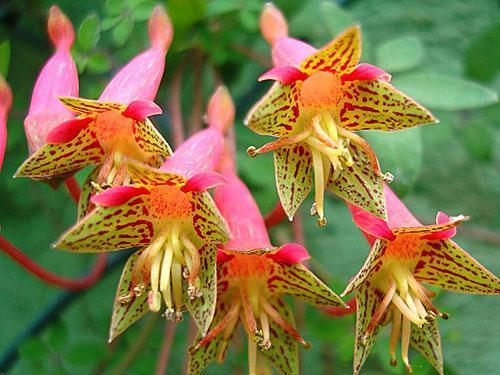 Perennial herbaceous curly nasturtium forms vines about 6 meters long, planted with pale green, palm-like leaves, like clover. Shoots can easily climb mountain slopes, rocky fences and even walls of buildings.
Perennial herbaceous curly nasturtium forms vines about 6 meters long, planted with pale green, palm-like leaves, like clover. Shoots can easily climb mountain slopes, rocky fences and even walls of buildings.
For the amazing shape, as in the photo, of nasturtium flowers in English-speaking countries, the plant was named "ladies' shoe" or "lady's leg". Indeed, the pinkish-red single flowers, just over a centimeter in size, amaze with their grace. When flowering is complete, bright blue rounded seeds appear in place of tiny corollas.
Multifoliate nasturtium (T. polyphyllum)
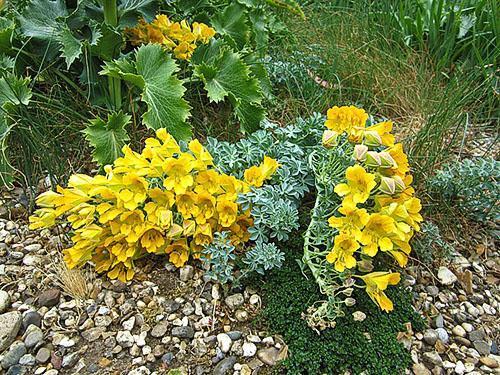 Liana up to 3 meters long, covered with small finger-like leaves of a silvery-green hue, is capable of forming large underground tubers, which successfully winter in the ground in a favorable area.
Liana up to 3 meters long, covered with small finger-like leaves of a silvery-green hue, is capable of forming large underground tubers, which successfully winter in the ground in a favorable area.
Nasturtium produces new shoots and bright yellow flowers throughout the season, and with the onset of cold weather, the entire aerial part dies off. After a mild winter, the tubers left underground give life to a new plant. In Russia, it is easier to propagate and grow this species by means of seeds.
Fine nasturtium (T. speciosum)
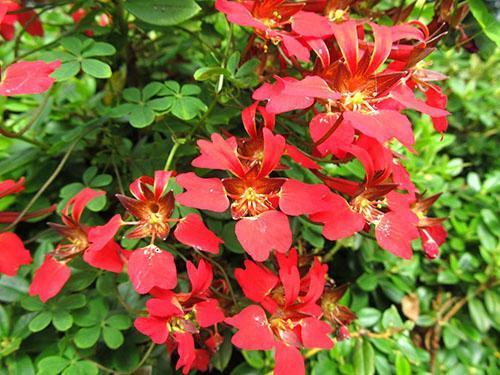 Perennial nasturtium with vines of three meters in length. Leaves are bright green with five lobes and well-visible longitudinal veins. When the openwork flowers, which have a deep red color, fade, blue fruits containing small seeds appear in their place.
Perennial nasturtium with vines of three meters in length. Leaves are bright green with five lobes and well-visible longitudinal veins. When the openwork flowers, which have a deep red color, fade, blue fruits containing small seeds appear in their place.
Nasturtium prefers an acidic loose soil, where it forms juicy fleshy tubers. When the soil dries out, the plant quickly loses its decorative effect, so the soil mulch and provide shading to the roots and bottom of the stems.
Tricolor nasturtium (T. tricolorum)
 Perennial South American liana with shoots at least 2 meters long is strewn with small five- or seven-fingered leaves. Flowering lasts about three months and is accompanied by the massive appearance of orange-scarlet flowers with a black border and a bright yellow heart on long thin burgundy peduncles. This type of curly nasturtium, unfortunately, does not tolerate frost extremely well, therefore, in the middle lane it is grown only indoors or using seedlings.
Perennial South American liana with shoots at least 2 meters long is strewn with small five- or seven-fingered leaves. Flowering lasts about three months and is accompanied by the massive appearance of orange-scarlet flowers with a black border and a bright yellow heart on long thin burgundy peduncles. This type of curly nasturtium, unfortunately, does not tolerate frost extremely well, therefore, in the middle lane it is grown only indoors or using seedlings.
Azure nasturtium (T. azureum)
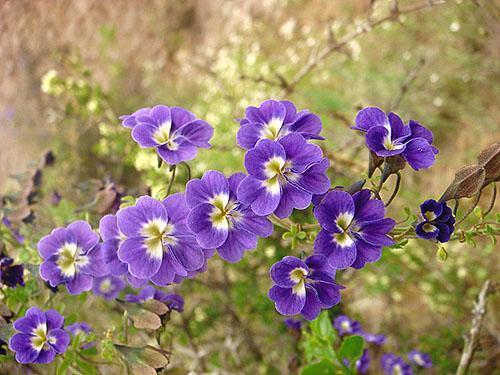 This perennial nasturtium, originally from Chile, is distinguished not only by its unusual beautiful blue shade of flowers, but also by their surprisingly elegant shape. The appearance of small flowers with five rounded petals, short spurs and a white-yellow center begins in May and lasts for a month. The height of the plant, which is a shrub in its homeland, ranges from 60 to 100 cm. In this case, the stems are covered with 2-cm palmate leaves of a pale green color.
This perennial nasturtium, originally from Chile, is distinguished not only by its unusual beautiful blue shade of flowers, but also by their surprisingly elegant shape. The appearance of small flowers with five rounded petals, short spurs and a white-yellow center begins in May and lasts for a month. The height of the plant, which is a shrub in its homeland, ranges from 60 to 100 cm. In this case, the stems are covered with 2-cm palmate leaves of a pale green color.
Short spur nasturtium (T. brachyceras)
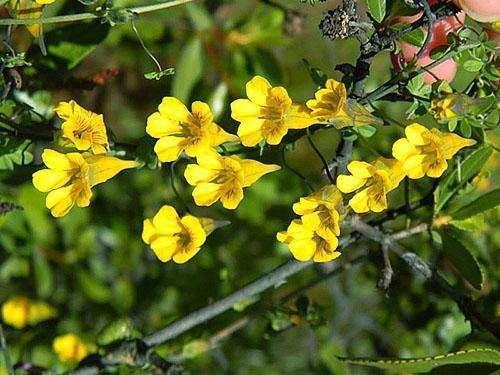 Bright yellow flowers with short wide spurs of pinkish color appear on thin peduncles and densely strewn curly stems of this type of nasturtium. The leaves are tiny, five-toed, very delicate.
Bright yellow flowers with short wide spurs of pinkish color appear on thin peduncles and densely strewn curly stems of this type of nasturtium. The leaves are tiny, five-toed, very delicate.
To speed up germination and bring flowering closer, they resort to the seedling method of planting nasturtium, which will take up to 2 months to take care of at home. Seeds are sown to a depth of one centimeter in fine sand, mixed with compost and kept at a temperature of 15 to 20 degrees. Seedlings appear only after 4–6 weeks or later. The seedlings that appear are distributed in separate peat pots, and when the plant is stronger, they are planted in a sunny place with well-drained soil.
Video about nasturtium
Among the many beautiful flowers, nasturtium has a special place. Most often it is found in dachas and in the design of balconies. It is used for vertical gardening, in hanging containers. But there are more simple and terry cultivars. The selection of various species from around the world is very interesting. I was especially surprised by the foreign nasturtium.Such beauty, delicacy and uniqueness of a flower can rarely be found. Tricolor nasturtium is good! This is how flowers on a long stem are presented, protruding above the greenery of the gazebo.
Such an ornamental plant, and even edible. I use green seeds and add them to the marinade. The leaves in the salad create a special flavor. It turns out that the thickened roots of tuberous nasturtium are used as potatoes. A bright spot of nasturtium in the garden always lifts the mood.